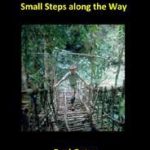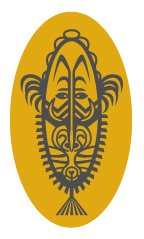A New Guinea Christmas
Paul Oates
During a police investigation in 1974, in the Sialum Patrol Post station office, I asked the village ‘komiti’ for his Village Book. This is the grey-blue book presented to each village on first contact, and into which an entry was supposed to be made whenever some government activity occurred. The Village Book was a running commentary of each government visit containing notes by government officers on any important points to be noted or followed up by subsequent patrols. By the end of World War II, most villages in ‘Controlled Territories’ had been issued with one of these books.
The Village Book for Gitua (a coastal village north of Sialum) contained comments going back to 1944 when the Japanese had been withdrawing towards Madang. An Assistant District Officer (ADO) had written about his conduct of the first village census after the Japanese had been forced out and had signed his entry, ‘Captain/Assistant District Officer’. Kiaps in those days had a military rank equivalent (either army or, in the case of some coastwatchers, naval), and it was thought this might help if they were captured, that they might be treated as a prisoner of war rather than shot as a spy for operating behind enemy lines.
The Captain/ADO’s report noted an increase in the population and recorded various misdemeanours that he had investigated. The entry also reported that the village was actively preparing for a special feast, celebrating the collecting of its share of the annual appearance of sea worms. Noting the date of the ADO’s entry was near the current date (November), I asked the old village ‘komiti’ if the feast was still celebrated and he assured me it was. Later that day, I buttonholed the village ‘komiti’ from Kwamkwam, just to the south of Sialum. Would I be able to witness this feast when it was due in roughly a week’s time? After some discussion, it was decided it was possible for me to attend, given that, as a white man, any taboos associated with the celebration would not apply.
The villagers all along the coast were keeping a close watch on the rising of the moon, the timing of which apparently triggered the appearance of the worms. When the moon rose late over the sea, not until about half past seven, the worms would be caught from the time the sun went down to the time the moon appeared. Just prior to this time, everyone was warned to stay away from the nearby rivers that ran down from the mountains and emptied into the sea. Traditionally, going near the rivers at this time would cause death. The village people said that it was rumoured that the worms came down the rivers and travelled into the sea. Maybe the ‘worms’ were small eels or elvers (baby eels), I wondered.
Not long after I enquired about attending the ceremony, people sent word that that night was probably ‘the night’. Towards late afternoon, my wife and I walked along the beach from our house to where villagers waited with canoes. Each dugout was fitted with an outrigger and, in the centre of the canoe, was an empty half 200-litre drum tied to the poles joining the canoe to the outrigger. Inside was a stack of coconut frond torches and a hand net made from mosquito netting. With each canoe team was a young girl holding a lighted torch (bum bum), a young man to operate the net (numbum), and a small boy whose duties included paddling the canoe and emptying the net into the drum.
In the tropics, the time between the sun going down and mosquitoes coming out is possibly the most peaceful period of the day. The waves from Vitiaz Strait rolled in, expending most of their energy on the reef before gently surging towards shore. At regular intervals, inside this reef, islets rose above the high-water mark: the worms were supposed to arrive through the gaps between them.
Towards sunset, canoes were launched as the young boys paddled towards these gaps in the reef. Hoping to observe the complete performance closely, I asked if I could accompany a canoe and, after a short discussion, it was agreed that I could. I was welcomed aboard a canoe and the young occupants paddled me to the reef where the rest of the flotilla awaited. Standing on a sharp coral island, I was surprised to see only teenagers and unmarried young people in the canoes. I was informed that the married or elderly could not participate in this part of the ceremony as their genitals would swell, causing death. Seeing the look on my face, all those around hastily assured me this did not apply to white men.
These thoughts were terminated abruptly when a young man suddenly yelled out, ‘Em nau, em pesman bilong ol.’ (Aha, there’s the first of them now!)
My young friends called me to where they stood in about two feet of water on the reef’s sandy top. At first, all I saw was a brown thread corkscrewing through the water. Then the water came alive. As the tide flowed in and the water reached my waist, hundreds and then thousands of worms arrived, clouding the water. Some worms were as long as 30 centimetres, while some were just five to 10 centimetres. The worms were about two to three millimetres in width, some rusty brown, some azure blue. It was not a pleasant feeling as worms slid around my body. I joined a team in a nearby canoe.
The technique for catching the worms was well known. Girls would light a torch and hold the glowing end just above the water. The flickering light seemed to attract the worms as they formed a seething mass under torchlight. Young men would scoop them up, handing a full net to the young boy in the canoe, who would then tip the squirming mass into an empty drum before quickly handing back the net. If the torch flared, worms would corkscrew away, so a steady light was essential to catching them.
By now, it was pitch black, and all along the coast, as far as I could see, lights flickered as each village proceeded to glean their share of the harvest. Gentle waves rocking the canoe helped create a surreal picture. Torchlights reflected off the surface in flashes of yellow, red, blue and purple as minute water creatures emitted their own blue-green phosphorescence. Combined with the phosphorescent slime from the worms, it was a memorable sight. As nets full of worms were tipped into the drums, phosphorescent slime drooled down the outside of the containers and clung to the bottom of the nets.
The netting went on for about two hours before the moon rose. As each drum filled, the canoe was paddled to the nearby beach, where waiting adults tipped the worms into saucepans.
At about eight o’clock, the moon rose and the worms disappeared. Everyone assembled on the beach to stuff the worms into lengths of hollow bamboo. These would be heated slowly on an open fire for about a day until the contents became a solidified, translucent mass to be eaten. The smell of cooking worms was very pungent. I politely thanked everyone and walked home. Before we left, I scooped up a few worms of each colour into a small bottle of seawater to study in daylight.
The next morning, much to my dismay, the worms in the bottle had all died. However, at the bottom of the bottle was a layer of blue eggs. I assumed that the blue worms might be female and the rusty brown ones male. I also assumed that the worms were coming to lay their eggs in the sand on the beach and then die, having completed their life cycle.
Before we left the beach that night, the villagers explained that this was their Christmas—Em Krismas bilong mipela. For a week after this feast, they would do no work in the village gardens or at the government station.
 This story is taken from an excerpt of Paul Oates’ book, Small Steps along the Way, available on Amazon at https://www.amazon.com.au/Small-Steps-Along-Paul-Oates/dp/1707077932
This story is taken from an excerpt of Paul Oates’ book, Small Steps along the Way, available on Amazon at https://www.amazon.com.au/Small-Steps-Along-Paul-Oates/dp/1707077932



